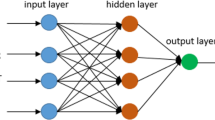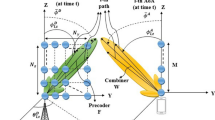Abstract
Sensor networks are used in various applications. Sensors acquire samples of physical data and send them to a central node in different topologies to process the data and makes decisions. Multiple Input Multiple Output (MIMO) systems showed good utilization of channel characteristics. In MIMO Sensor Network, multiple signals are transmitted from the sensors and multiple antennas are used at the control node. This provides each receiver the whole combined signal and hence, array processing techniques helps in reducing the effects of noise. In this paper we devise the use of MIMO sensor network and array decision techniques to reduce the noise effect. The proposed Constrained Best Linear Unbiased Estimator (CBLUE) and Constrained Weighted Least Square (CWLS) estimators showed good performance BER when used with MIMO Sensor Network. Most importantly these estimates showed good perturbation results when the estimated channel matrix is not accurate. The condition for good performance was to have the number of receiving antennas at the central node to be equal to the number of transmitting sensors and no significant improve was seen if the number of antennas is greater than the number of transmitting sensors. If the number of sensors is greater than the number of receiving antennas, time or frequency multiplexing is possible to keep good performance for the devised system. Enhancing the BER results in longer battery life at sensor nodes.
Similar content being viewed by others
References
Liang J., Liang Q. (2009) Channel selection in virtual MIMO wireless sensor networks. IEEE transactions Vehicle Technology 58(5): 2249–2257
Cui S., Goldsmith A. (2004) Energy-efficiency of MIMO and cooperative MIMO techniques in sensor networks. IEEE Journal Selection Areas Communications 22(6): 1089–1098
Uysal-Biyikoglu E., El Ga A. (2004) On adaptive transmission for energy efficiency in wireless data networks. IEEE Transactions Informatics Theory 50(12): 3081–3094
Jiang Y., Li J., Hager W. W. (2005) Uniform channel decomposition for MIMO communications. IEEE Transactions On Signal Processing 53(11): 4283–4294
Jayaweera S. K. (2006) Virtual MIMO-based cooperative communication for energy-constrained wireless sensor networks. IEEE Transactions Wireless Communications 5(5): 984–989
Li Y., Xia X.-G. (2007) A family of distributed space-time trellis codes with asynchronous cooperative diversity. IEEE Transactions On Communications 55(4): 790–800
del Coso A., Spagnolini U., Ibars C. (2007) Cooperative distributed MIMO channels in wireless sensor networks. IEEE Journal Selection Areas Communications 25(2): 402–414
Yuan Y., He Z., Chen M. (2006) Virtual MIMO-based cross-layer design for wireless sensor networks. IEEE Transactions Vehicle Technology 55(3): 856–864
Thatte G., Mitra U. (2008) Sensor selection and power allocation for distributed estimation in sensor networks: Beyond the star topology. IEEE Transactions On Signal Processing 56(7): 2649–2661
Gershman, A. B., Sidiropoulos, N. D. (eds) (2005) Space-time processing for MIMO communications. John Wiley & Sons Ltd, London
Unnikrishan Pillai S. (1989) Array signal processing. Springer-Verlag, Berlin
Caire G., Taricco G., Biglieri E. (1999) Optimum power control over fading channels. IEEE Transactions Informatics Theory 45(5): 1468–1489
Kay S. M. (1993) Fundamentals of statistical signal processing: Estimation theory. Printice Hall PTR, Englewood Cliffs, NJ
Luo J., Lin L., Yates R., Spasojevic P. (2003) Service outage based power and rate allocation. IEEE Transactions Informatics Theory 49(1): 323–330
Simon M. K., Alouini M.-S. (2005) Digital communication over fading channels (2nd ed.). John Wiley, London
Proakis J. (2001) Digital communications (4th ed.). McGraw-Hill, New York
Author information
Authors and Affiliations
Corresponding author
Rights and permissions
About this article
Cite this article
Rahhal, J.S. Wireless MIMO Sensor Network with Power Constraint WLS/BLUE Estimators. Wireless Pers Commun 63, 447–457 (2012). https://doi.org/10.1007/s11277-010-0142-1
Published:
Issue Date:
DOI: https://doi.org/10.1007/s11277-010-0142-1




